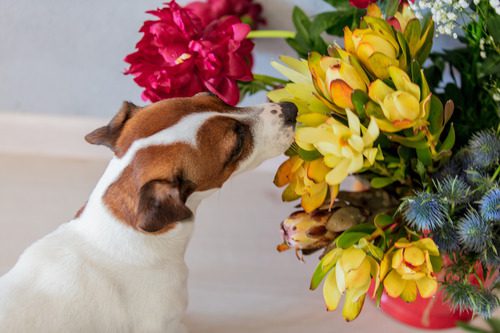Plants That Are Toxic to Dogs
Dogs are naturally curious, and their playful nature often leads them to explore their surroundings with their mouths. Unfortunately, many common household and garden plants can pose a serious threat to their health. Some plants can cause mild digestive upset, while others can lead to severe poisoning. If you suspect your dog has ingested a harmful plant, call Frontier Veterinary Urgent Care at 262-226-2055 right away.

What Are Some Common Household Plants That Are Toxic to Dogs?
Many popular houseplants can be dangerous for dogs if ingested. While these plants add beauty to your home, it is essential to keep them out of reach of your pets.
Peace Lily (Spathiphyllum)
Peace lilies are a common indoor plant that can cause significant discomfort for dogs. The plant contains insoluble calcium oxalates, which irritate the mouth, throat, and digestive system. If a dog chews on or ingests part of a peace lily, symptoms may include drooling, pawing at the mouth, vomiting, and difficulty swallowing. While peace lilies are not fatal, they can cause considerable distress and require veterinary attention.
Aloe Vera
Aloe vera is widely known for its soothing properties for human skin, but it is toxic to dogs. The plant contains saponins and anthraquinones, which can cause vomiting, diarrhea, lethargy, and tremors if ingested. If you use aloe vera for medicinal purposes at home, store it safely where your dog cannot access it.
Pothos (Epipremnum aureum)
Pothos, or devil’s ivy, is a resilient houseplant that thrives in many environments. However, it contains calcium oxalates, which can irritate a dog’s mouth, leading to pain, excessive drooling, and difficulty swallowing. In severe cases, pothos ingestion can cause breathing difficulties and require immediate veterinary care.
Outdoor Plants That Pose a Threat to Dogs
Gardens and yards often contain plants that can be harmful to dogs. Whether growing naturally or intentionally planted, certain outdoor plants can be extremely toxic.
Sago Palm (Cycas revoluta)
The sago palm is one of the most dangerous plants for dogs. Every part of the plant, especially the seeds, contains cycasin, a toxin that can lead to severe liver damage. Symptoms of sago palm poisoning include vomiting, diarrhea, lethargy, seizures, and even liver failure. Ingestion of even a small amount requires immediate veterinary intervention.
Azaleas and Rhododendrons
Azaleas and rhododendrons contain grayanotoxins, which can interfere with a dog’s nervous system. Symptoms of ingestion include vomiting, diarrhea, drooling, abnormal heart rate, tremors, and weakness. In severe cases, azalea poisoning can lead to coma or death, making it critical to seek veterinary care if ingestion occurs.
Foxglove (Digitalis purpurea)
Foxglove is a striking garden plant, but it is highly toxic to dogs. It contains digitalis, which affects the heart and can cause irregular heartbeat, vomiting, diarrhea, drooling, and even sudden death. If your dog consumes foxglove, contact an urgent care veterinarian immediately.
Seasonal Plants and Flowers That Can Harm Dogs
Certain plants are more common during specific seasons, posing a heightened risk depending on the time of year.
Tulips and Daffodils
Spring-blooming flowers like tulips and daffodils contain toxic alkaloids that can cause vomiting, diarrhea, and abdominal pain in dogs. The bulbs contain the highest concentration of toxins, making them particularly dangerous if dug up and eaten. Severe cases can lead to heart and respiratory complications.
Autumn Crocus (Colchicum autumnale)
Autumn crocus is a beautiful fall-blooming plant that contains colchicine, a toxin that can cause severe gastrointestinal distress, kidney and liver damage, and respiratory failure. Symptoms may not appear immediately, making it especially dangerous.
Mistletoe and Holly
During the winter holiday season, mistletoe and holly are common decorations, but both pose risks to dogs. Mistletoe contains substances that can cause vomiting, diarrhea, difficulty breathing, and abnormal heart rate. Holly berries can also lead to vomiting and diarrhea. If decorating with these plants, ensure they are kept out of reach.
Symptoms of Plant Poisoning in Dogs
If your dog ingests a toxic plant, symptoms may vary depending on the type of plant and the amount consumed. Common signs of plant poisoning include:
- Vomiting and diarrhea
- Drooling or foaming at the mouth
- Loss of appetite
- Lethargy or weakness
- Difficulty breathing
- Tremors or seizures
- Abnormal heart rate
If you notice any of these symptoms or suspect your dog has ingested a toxic plant, contact Frontier Veterinary Urgent Care at 262-226-2055 immediately. Prompt veterinary care can make a critical difference in your pet’s health.
How to Prevent Plant Poisoning in Dogs
Keeping your dog safe from toxic plants requires proactive steps to minimize exposure.
- Choose pet-friendly plants: Opt for non-toxic indoor and outdoor plants to reduce risk.
- Monitor outdoor activities: Supervise your dog in areas where toxic plants may be present.
- Secure plants out of reach: Place houseplants on high shelves or use hanging planters.
- Train your dog: Teach commands like “leave it” to discourage chewing on plants.
- Be cautious with gifts and bouquets: Many floral arrangements contain dangerous plants like lilies, which are highly toxic to pets.
Understanding which plants are toxic to dogs is essential for creating a safe home and garden environment. Many common plants pose serious health risks, and knowing what to look for can help prevent dangerous situations. If you suspect your dog has ingested a harmful plant, seeking veterinary care immediately is the best course of action. Call Frontier Veterinary Urgent Care at 262-226-2055 for professional assistance and peace of mind.
